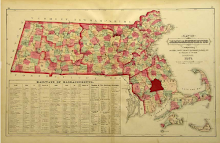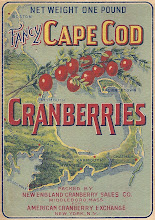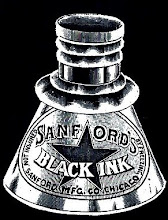 During the last decades of the nineteenth century, the Chicago meat-packing industry devoted its efforts to penetrating markets throughout the nation, a goal suddenly made possible through technological advances, including the development of the refrigerated rail car or “reefer”. Particularly prized by Chicago was the lucrative Eastern market and by 1881, Swift was shipping 3,000 carcasses weekly to Boston, the main distribution point for New England. Eventually, in order to further penetrate the market, Swift selected smaller, more local distribution points where wholesale cold storage warehouses were raised to facilitate the distribution of beef to retailers throughout the region.
During the last decades of the nineteenth century, the Chicago meat-packing industry devoted its efforts to penetrating markets throughout the nation, a goal suddenly made possible through technological advances, including the development of the refrigerated rail car or “reefer”. Particularly prized by Chicago was the lucrative Eastern market and by 1881, Swift was shipping 3,000 carcasses weekly to Boston, the main distribution point for New England. Eventually, in order to further penetrate the market, Swift selected smaller, more local distribution points where wholesale cold storage warehouses were raised to facilitate the distribution of beef to retailers throughout the region.One such distribution point was Middleborough. In August, 1887, it was reported that “an agent of the Swift Dressed Beef Company, of Chicago, has been looking around for a place to establish a refrigerator building at Middleboro, from which to supply that section of the state”. The president of the firm, Gustavus F. Swift, and his brother Edwin C. who headed up the company’s New England operations were previously familiar with Middleborough, both having been born and raised in Sagamore and having traveled through Middleborough by train numerous times. Undoubtedly, they were well aware of the importance of the town’s rail connections.
The site which the company settled upon in Middleborough was a lot owned by Peter and Charles P. Washburn which was situated upon the south side of the present Center Avenue adjacent to the Old Colony Railroad Freight House. The Washburns at the time operated a portion of their business from this lot upon which were located their hay scales. The lot had earlier been owned by Philander, William R. P. and Abiel Washburn who had acquired it through their father, General Abiel Washburn, who had first purchased the lot as part of a larger parcel in 1796.
Although the Swifts purchased the parcel in 1887, no action was taken towards the property’s use for another five years. In April, 1892, it finally was announced that “E. C. Swift & Co. of Chicago, the wholesale meat dealers, are to erect a large branch storehouse at Middleboro, this spring, near the freight depot.”
 The two-story cold storage warehouse constructed by the company measured approximately 24 by 40 feet. What made the building unique was its hollow wall construction, a design feature noted for its insulating properties and one which was commonly employed in ice houses of the era, as well as its windows which consisted of three sashes. Like many such cold storage warehouses built for Swift at the time, the Middleborough building was indicative of that company’s rapid expansion during this period, and its increasing presence in New England.
The two-story cold storage warehouse constructed by the company measured approximately 24 by 40 feet. What made the building unique was its hollow wall construction, a design feature noted for its insulating properties and one which was commonly employed in ice houses of the era, as well as its windows which consisted of three sashes. Like many such cold storage warehouses built for Swift at the time, the Middleborough building was indicative of that company’s rapid expansion during this period, and its increasing presence in New England.Initially, there had been much resistance to Swift’s efforts to penetrate Eastern markets. Butchers and meat dealers feared increased competition from the Chicago-based meatpacking giant, while the consumers remained skeptical of the safety of beef slaughtered and dressed weeks earlier. While there is no record of the views of Middleborough slaughterers and butchers, they too most likely opposed Swift’s presence. Eventually, however, in Middleborough, as elsewhere, public concerns were overcome through Swift’s skillful advertising, coupled with the quality and low prices of its products.
 For a generation, local grocery retailers and meat market operators in the vicinity purchased Swift products from the Middleborough warehouse. A 1904 valuation list referred to the plant as the “Market Building” owned by G. T. and E. C. Swift of Boston though the Swifts had transferred their individual titles in September, 1902, to Swift and Company. A non-descript, functional building, the warehouse did achieve a small degree of local notoriety in 1912 when the roof of the warehouse caught fire from sparks from a passing locomotive. What made the event notable was that it marked only the second time the Middleborough fire department had utilized its new “automobile firetruck.”
For a generation, local grocery retailers and meat market operators in the vicinity purchased Swift products from the Middleborough warehouse. A 1904 valuation list referred to the plant as the “Market Building” owned by G. T. and E. C. Swift of Boston though the Swifts had transferred their individual titles in September, 1902, to Swift and Company. A non-descript, functional building, the warehouse did achieve a small degree of local notoriety in 1912 when the roof of the warehouse caught fire from sparks from a passing locomotive. What made the event notable was that it marked only the second time the Middleborough fire department had utilized its new “automobile firetruck.”The beef warehouse was utilized for that purpose through the close of World War I. Some have maintained that the structure was not erected until 1917 by the Army Corps of Engineers to store beef destined for soldiers at Camp Joe Hooker in Lakeville. While the building clearly predated 1917, this view reflects the likelihood that the Army procured beef through Swift for soldiers then training at the camp during the war.
In 1919, if not earlier, Swift and Company closed its Middleborough operation, disposing of the warehouse in February, 1920, to the Colonial Casket Company of Middleborough, with the stipulation that the warehouse not be utilized “in any way for the purpose of carrying on of the wholesale meat business, for the period of ten years from the date hereof.”
The Colonial Casket Company did not long operate in the building. By 1932, it was occupied by the C. P. Washburn Company which was leasing it for use from the Casket Company for “general storage.” In August, 1940, the Middleborough Trust Company, holder of a mortgage from the Colonial Casket Company dated March 7, 1923, foreclosed upon the property when the company defaulted and the following year, in October, 1941, it was sold to C. P. Washburn, his wife Mary E. Washburn, and their sons C. P., Jr., William K., John A. and Stewart A. The Washburn Company continued to utilize the building to accommodate a portion of its building supply business, which operated a lumber yard and showroom across the railroad tracks on Vine Street. Because of its history, members of the Washburn family long referred to this building as the “Meat House”.
The former cold storage warehouse burned in 1996, and the vacant lot is now owned by the Town of Middleborough.
Illustrations:
Sources:
Plymouth County Deeds 85:36, 434:191, 550:393, 554:523, 867:24, 1346:5031
Romaine, Mertie E. History of the Town of Middleboro, Massachusetts. Volume II. Middleborough, MA: Town of Middleborough, 1969.
"Valuations for the Town of Middleborough for the Year 1904" in Annual Report of the Town Officers of Middleborough, Mass., for the Year 1904. Middleborough, MA: Town of Middleborough, 1905.






















+of+Smoky+Mountains+018.jpg)
0 comments:
Post a Comment